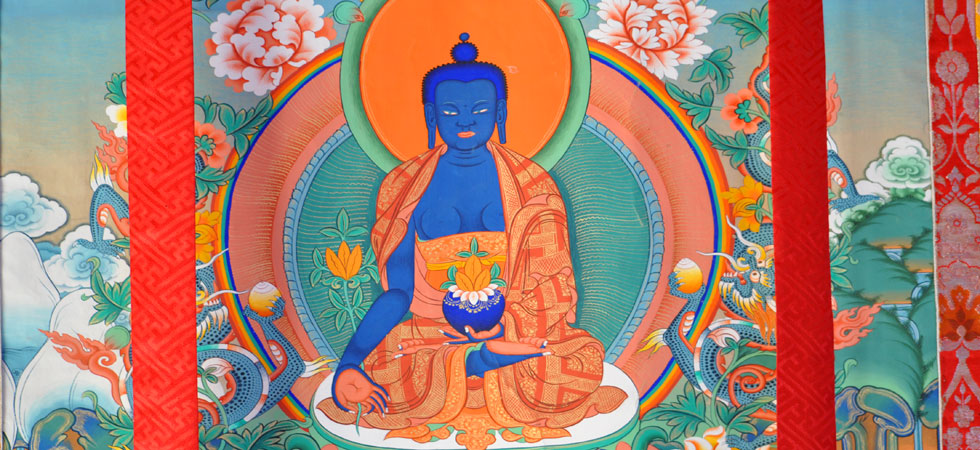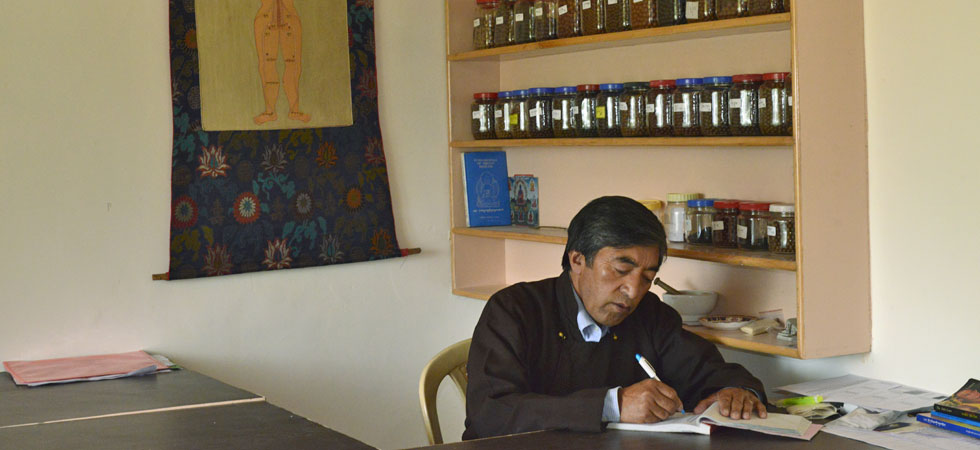Tibetan Medicine Theory
The Five elements and the Three Humours
One of the basic principles of Tibetan medical theory is that everything in the macrocosmic environment and the microcosm of the human body is made up of various combinations of the five elements of earth, water, fire, air and space. Another fundamental principle is the notion that all psycho-physical processes in the body can be divided into three categories or energetic functions, which drawing on Galenic terminology, are usually referred to in English as 'humours'. The Tibetan word nyépa that is usually translated as 'humour', actually means 'fault' or 'wrong doing'. In order to understand why the Tibetan word has this meaning we need to consider the relationship between Tibetan Buddhism and medicine.
At the very foundation of Tibetan medical notions about health and disease lies the Buddhist concept of the 'three mental poisons'. The root cause that leads beings to be born into the cycle of death and rebirth is a deep fundamental ignorance of their own nature, this leads to a false sense of self, which in turn leads to the 'three mental poisons' of ignorance, desire, and aggression. According to Tibetan medical theory, the 'three mental poisons' generate the three humours in the human constitution: desire is the cause of wind (Tibetan, lung), aggression is the cause of bile (Tibetan, tripa), and ignorance is the cause of phlegm (Tibetan, peken). The three humours have a dual nature: if they are in their right proportions and locations, they generate health and well being; but if by some means they are disturbed, this will result in sickness. Following the Buddhist notion that suffering is innate to all forms of life that exist within the cycle of death and rebirth, the humours are named only according to their negative aspect as 'faults'. Following from this philosophical position, the medical text graphically likens the inherent disposition of the humours to generate sickness to an insect becoming poisoned as a consequence of feeding on a poisoned tree.
Now let us consider the characteristics and functions of the three humours in the human constitution. The three humours are related to the five elements: wind has the elemental nature of air; bile that of fire; and phlegm that of earth and water. The humours are referred to in Tibetan by names, which when translated into English denote specific physical referents, but the Tibetan terms lung, tripa and peken refer to much more than what is denoted by the English words 'wind', 'bile' and 'phlegm'. Although the three humours permeate the entire body, each is associated with a certain area of the body: wind is located in the heart region and in the area below the navel; bile is located in the region between the navel and the heart; and phlegm is located in the area above the heart. According to Tibetan medical theory there are five forms of each of the humours. Each of these subdivisions is responsible for certain psychological and physiological functions and is also associated with a specific location in the body. The three humours of lung, tripa and peken are the guiding forces underlying all psychological and physiological process.
The Cause of Sickness
According to Tibetan medical theory, health is experienced when the various components of the human constitution, the three humours, the seven bodily constituents (the essential nutriment, blood, flesh, fat, bone, marrow, and regenerative fluid) and the three forms of excreta (stool, urine and sweat) are functioning in a balanced and harmonious manner. For the three humours this means that they remain in their correct locations and proportions. In Tibetan medical theory there are numerous causative factors that can bring about sickness. General causes of disease are related to such factors as negative influences from the environment (such as seasonal changes), poisons, incorrect behaviour, and infection. Specific causes of disease are related to the humour's properties. For example, wind is said to be: rough, light, cool, subtle, firm and mobile. If any factor is present which has any of these properties, and this cause is sustained for a prolonged period of time, this will bring about pathological conditions in the wind humour.
Tibetan medical theory lists three forms of modification that a humour goes through when it is disturbed. The first stage is 'accumulation'. When a cause is present that has similar properties to the humour this will first lead it to accumulate in its own location. As the humour accumulates, a natural process ensues where one begins to desire forms of behaviour or diet, which have the opposite qualities of the humour. The following stage is 'arising', when the humour becomes pathogenic and spills over into the pathways of the other humours; it is at this time that symptoms of the pathological condition manifest in the body. The third stage is 'calming'; this refers to the time when the disturbed humour is returned to a state of balance in its own location by appropriate diet, behaviour and therapy. Disorders may involve a disturbance in one, two or all three of the humours combined.
What is important to note here is that the focus in Tibetan medicine is not so much on biological substrata, that is to say with specific bodily components, but on the functioning of the system as a whole, which is governed by the three humours. Organic disorders are considered to be preceded by a series of functional disorders; if they are recognised in time they can be prevented from reaching the organic stage.




